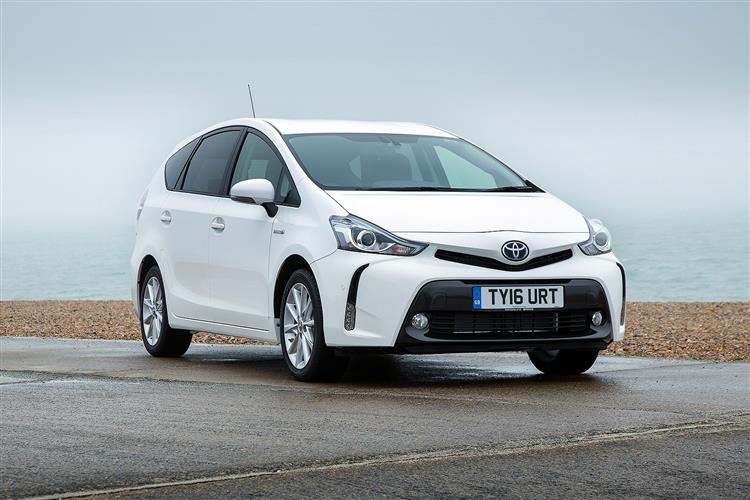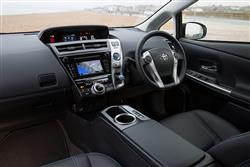This is a sample, showing 30 seconds of each section.
PLUS POINTS (some text hidden) SECTIONED_new_ToyotaPriusPlus_2012
By Jonathan Crouch
Introductionword count: 41
Toyota's Prius+ enabled larger families to also join the hybrid-powered tax-efficient clean and frugal fraternity. With citycar-style emissions and MPV-style versatility, it's the kind of People Carrier that'll appeal if, for you, seven-seat transport must tread lightly on our polluted planet.
Modelsword count: 14
5 door MPV (1.8 Hybrid - petrol) [Active, Business Edition, Business Edition Plus, Excel]
Historyword count: 259
In an age when we have hybrid sportscars, SUVs and superminis, the lack of this technology in the MPV People Carrier segment might seem rather surprising. You can find it though - in the form of this car, Toyota's Prius+ MPV, introduced in 2011. There's a reason why you don't get many full-hybrid People Carriers of course. Hybrid car design usually has to find space for the siting of a huge battery pack, normally located just over the rear axle: exactly where you'd want to place the third row accommodation in a seven-seater MPV. Which is why we never had a hybrid able to take more than five people - until the launch of the Prius+. Toyota was able to design it thanks to better battery technology introduced at the end of the New Millenium's first decade, the kind consumers pushed for with the need for longer-lasting laptops and smartphones. These use small but powerful lithium-ion units, more advanced versions of which by the time of this Prius+'s launch in 2011 were starting to replace the big, heavy nickel-metal hydride batteries traditionally used in hybrid cars. These had to be sited at the back of the car due to their size, but the more compact lithium-ion packs didn't have to be. Which meant that in this Prius+, the first non-Plug-in hybrid Toyota to use this technology, the battery could be mounted between the two front seats, freeing up space for the rearward third seating row that made this Europe's first full hybrid seven-seat vehicle. It sold until early 2021.
What You Getword count: 578
The Prius+ model's characteristic 'triangle' silhouette means that despite its rather different remit, you'd recognise this as a member of the Prius family. So you get the familiar arched roofline and neat fastback rear end in a design that's 30mm wider and 85mm higher than Toyota's trendsetting hybrid hatch - but only 135mm longer. Not enough, you might surmise, to properly accommodate third row seating ready and able to take two fully-sized adults for long distances in the way that, say, a Ford Galaxy or a VW Sharan might be able to manage. You'd be right to think that. They're not too difficult to get to, but the rearmost pair of seats are indeed best left for small kids. Still, a combination of the standard panoramic roof and a thin, curved seatback design means that a place right at the very back isn't quite as claustrophobic as the compact exterior dimensions might lead you to expect. Provided that you're not too tall: Toyota's decision to place each seating row 45mm higher than the one in front does certainly offer everyone a good view out, but it also means that headroom's a tad restricted by the time you get to the very back. Still, adults over shorter distances will just about fit if those in the row ahead are prepared to help out by making use of the way their chairs can slide forward. In the middle row, there is, as you would expect, an awful lot more room than you'd get in an ordinary Prius hatch, thanks to three individual chairs you can not only push back and forth but also fold - and recline by up to 35-degrees for greater comfort on longer journeys. And up-front? Well it's certainly spacious here too, something you'll appreciate once you've adjusted to a fascia that's anything but conventional, with no binnacle in front of the driver. Instead everything sits on the rather densely-packed centre stack, with display screens, parking brake, starter button, gear selector, ventilation and stereo controls all in close proximity. We've seen better presented, more up-market-looking layouts, but with familiarity, it all falls to hand easily enough and the minor controls you use most often are available from the steering wheel. Included on the fascia display is a digital speedometer, but you'll hardly ever look at it as the same information's also projected onto bottom part of the windscreen so that you can more easily keep your eyes on the road. As for cabin stowage space, well, if you're aware of the location of the hybrid battery pack between the front seats, you might expect a few compromises here. As it is, things have been packaged well enough for most family folk not to notice, thanks to the provision of big doorbins, two gloveboxes and a side-opening centre console storage section that can take up to eight CDs. As for cargo capacity, well, with all seats in place, there's 232-litres of cargo space to the roof. Not a great deal, though to be fair, we should also point out that there's also a 60-litre storage tray beneath the luggage deck which keeps your valuables out of sight or can be used for wet or dirty gear. More typically though, you'll be using the car with the third row seating folded flat, in which case, you'll have up to 784-litres to play with. Fold all but the front seats and you can boost that figure to a useful 1,750-litres.
To see the full road test text contact us on 0330 0020 227
Pictures (high res disabled)

.jpg)
|
.jpg)
|
.jpg)
| |||
.jpg)
|
.jpg)
|
.jpg)
| |||
.jpg)
|
.jpg)
|

|
Scoring (subset of scores)
Category: Hybrid, Plug-in, Electric & Hydrogen
| Performance | |
| Handling | |
| Comfort | |
| Space | |
| Styling, Build, Value, Equipment, Depreciation, Handling, Insurance and Total scores are available with our full data feed. | |



